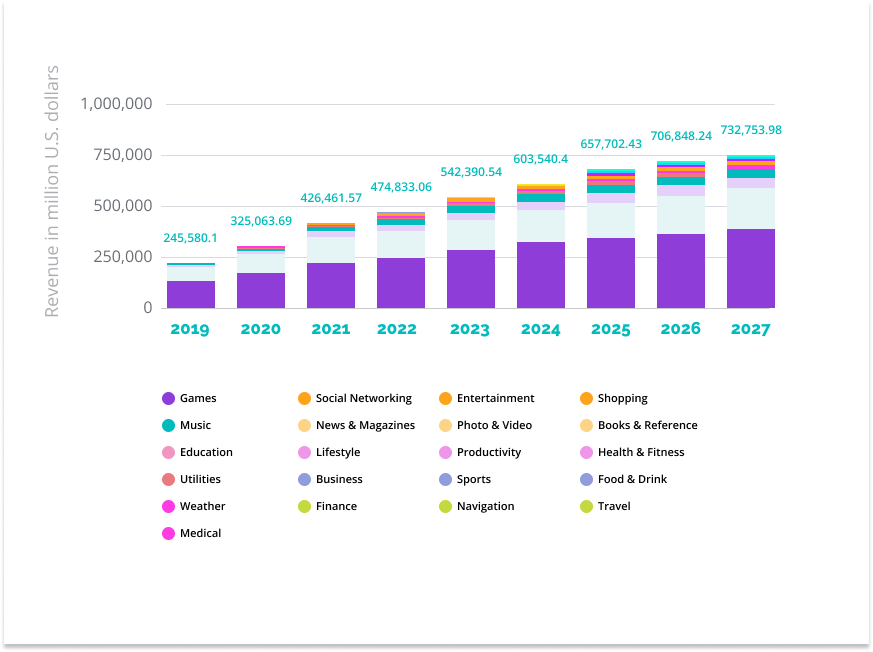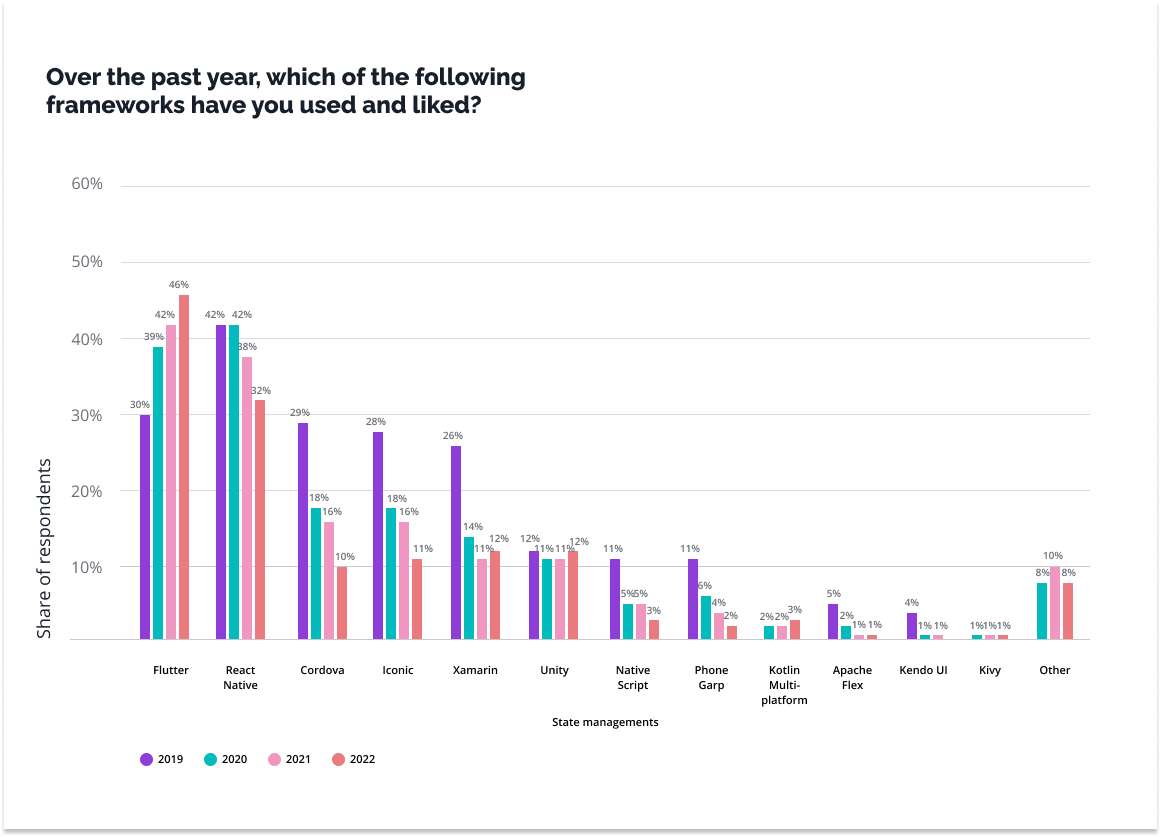
Leveraging Native SDKs with KMM: Enhanced Integration for Android and iOS Compared to Flutter and React Native

The popularity of mobile applications is growing year after year, no matter what the purpose of the application. And while mobile gaming and social media are the biggest segments of the market, it is easy to see the growing interest in other areas as well, from general entertainment through online shopping to sports and recreation.

Source: https://www.statista.com/forecasts/1262892/mobile-app-revenue-worldwide-by-segment
Certainly, the COVID-19 pandemic, which forced many providers to develop mobile solutions, has contributed to such results. And since necessity is the mother of invention, it isn’t surprising that more and more freely available development tools are providing more efficient solutions for creating Android and iOS applications.
The solutions have been and still are various – from native, i.e., dedicated to specific systems, to multiplatform, which gives developers flexibility and allows them to work on Android and iOS apps in the same way. However, each of these options had its limitations, so there was a need for a solution that would allow flexible multiplatform work while maintaining access to native SDKs.
KMM, the Kotlin Multiplatform, solves this problem by allowing direct interaction with native modules, giving developers virtually complete freedom to use native features as soon as they become available on the appropriate platforms.
This not only speeds up the development process but also reduces reliance on third-party solutions, as in the case of React Native or Flutter, potentially increasing the stability and security of the application.
Benefits of integrating KMM with native Android and iOS technologies
The paper will put up with anything that is written on it, so the benefits of integrating KMM with native technologies are best presented with concrete examples. We have prepared five of the most important from the point of view of the development team, but also from the point of view of the investor. After all, smoother and more accessible work, as well as more effective solutions and tools, increase the chances of application success.
NO WAITING FOR FRAMEWORK UPDATES
While KMM cannot compete with the popularity of React Native or Flutter, it offers capabilities that are harder to come by with the leading frameworks.

Source: https://www.statista.com/statistics/869224/worldwide-software-developer-working-hours/
In the case of the aforementioned React Native or Flutter, by now the two most popular solutions, access to native features can be limited and dependent on framework updates. And that makes the whole creative process much more difficult.
KMM excels at this because it allows developers to use native APIs directly without waiting for the hybrid framework to support them. This is especially beneficial when new platform features are released, as KMM projects can adopt them immediately.
This dependence on the update cycle of these tools can delay the implementation of innovation, which is critical in a business where time is of the essence. As a result, when platforms introduce new capabilities, KMM projects can take advantage of them without delay, which is invaluable in situations where you need to react quickly to market changes or innovate.
RAPID IMPLEMENTATION OF NEW FEATURES
We already touched on this benefit a bit above, but in the real world, such a feature has a significant impact on work efficiency, so it is worth expanding on the topic.
With KMM, developers can quickly implement new features on both mobile platforms without waiting for them to be deployed through a framework. This accelerated feature deployment is critical for companies seeking to respond quickly to changing market conditions or user expectations.
The importance of this can be seen, for example, in-store ratings (Google Play and App Store) or comments. This ability to quickly implement innovations not only gives companies an advantage in the marketplace but also improves their brand image. After all, users want to take full advantage of the latest innovations and often choose the apps that make the best use of their devices’ capabilities.
In this context, the role of being able to respond quickly to user feedback, both positive and negative, cannot be underestimated. This is particularly important in crisis situations, such as the need to improve security or application performance promptly.
FULL CONTROL OVER NATIVE CODE
Among the many various benefits, it is extremely important to have complete control over native Android and iOS code, which is required for advanced applications and access to specific features. This control is crucial for applications with complex or high-performance requirements.
This freedom allows, for example, better integration with the operating system or using its latest features. For data-intensive applications such as games, educational applications, or video editing tools, access to native libraries and features is fundamental to ensure smooth operation and optimal use of resources.
What’s more, native code control allows developers to perform complex algorithms and operations that are critical for high-security applications such as banking and payment systems. We are well aware of this, as we have developed many applications for leading banks, which has sensitized us to their needs and shown us how different tools allow them to achieve their goals.
PLATFORM-SPECIFIC OPTIMIZATIONS
From the perspective of well-performing mobile applications, there is one word that holds a special place in the hearts and minds of developers, and that is “optimization”. And KMM allows them to implement platform-specific optimizations that can deliver performance and efficiency benefits.
By allowing developers to write platform-specific code, KMM improves application performance, appearance, and operation on any platform.
In addition to the user interface, optimization also applies to other aspects of the application, such as memory management, CPU usage, and database interactions. KMM provides tools and libraries to effectively manage these resources, which is especially important for applications that run in the background or need to perform complex calculations.
At the same time, by sharing code across platforms, KMM reduces redundancy and provides more consistent, less complex codebase management. This translates into faster development times and lower maintenance costs. As a result, KMM offers a unique combination of versatility and specialization, making it a uniquely attractive choice for companies and developers aiming to create high-end mobile applications.
MAINTAINING UI CONSISTENCY
And last but not least, maintaining user interface consistency between Android and iOS by sharing business logic. What does this mean in practice, and why is it so important?
This means that the core functionality of the application remains consistent, providing a unified user experience across devices, even as the user interface is developed using platform standard components.
In real life, this means that users who use the same mobile application on different devices – whether it be an iPhone or an Android device – will experience the same functionality. This is important because people expect their experience with the app to be consistent no matter what device they are using. Because the business logic is shared, they can easily switch between devices, maintaining continuity of experience.
In addition, the feedback is consistent regardless of whether it comes from a Samsung user, an iPhone user, or a completely different model.
One challenge often faced by developers using hybrid frameworks such as Flutter or React Native is relying on third-party or community plugins to access platform-specific features, which may not always be up-to-date or fully compatible with the latest platform updates.
KMM solves this problem, but does that automatically mean it is the best option on the market? Of course not, but for some applications or purposes, it may be the perfect one.
Individual requirements, limitations, or preferences should dictate the choice. The tool should be tailored to them, never vice-versa, as the restrictions of some solutions may ruin ideas or even specific functionalities.
Our company has extensive experience in the development of mobile applications using various frameworks, which allows us to provide in-depth advice at every stage of the development and implementation of the project. If you need help in this area, don’t hesitate to contact us, and we will be happy to help you with your plans.
